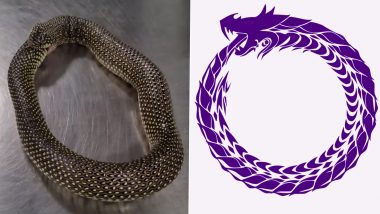If you are not particularly fond of snakes, then even the sighting of these serpents can make one squirm. Snakes do have a bad reputation that evokes a response of fear from many. There are enough videos of snakes that keep coming online every few days. Sighting and rescue of snakes make it to the news more often. Have you ever heard of snakes eating themselves? No, we do not mean snakes eating other snakes, but a snake that bites and chews on its own tail. There's a symbolic term for it called Ouroboros (or Uroboros) particular for this behaviour of snakes. In this article, we tell you more about why snakes eat themselves and what does Ouroboros mean. Hungry Snake Eats Itself, Swallows Almost Half of Its Body (Watch Rescue Video).
Why Snakes Eat Themselves?
The many times when snakes have been captured eating on themselves is by mistake. A hungry snake can mistake its own tail for another snake and start chewing on it. Now it has also got to do with their body temperatures. When a snake body temperature gets overly hot they get angry. They get confused and mistake their own tail to that of another snake. If the snake happens to be shedding, they can mistake the tail to be of another snake. 'Lucky' Tiger Cub Born in Sariska Reserve of Rajasthan: Know What is Infanticide in Carnivores and Why This Newborn Becomes a Special One.
There are snakes that eat other snakes, like kingsnakes, coral snakes, rattlesnakes etc. So biting on their tail mistaking it to be another prey is common. Sometimes when a snake is kept in a very small enclosure, it over time gets uncomfortable with the temperature and humidity inside. That stress can turn into disorientation in which they eat themselves. It could also be in case of extreme hunger that a serpent turns to itself for nourishment if they cannot hunt in poor health.
Check Video of Snake Eating Itself:
Ouroboros
This behaviour of snakes eating themselves has a symbolic term called Ouroboros. It is a symbol from ancient Egyptian iconography that depicts a serpent eating its own tail forming a circle. It is interpreted as a symbol for eternal cyclic renewal or a cycle of life, death, and rebirth. Accordingly, it is also a fertility symbol, wherein the tail symbolises a phallic object and the mouth is a womb-like symbol. It is one of the oldest mystical symbols in the world. This concept also has a reference in the Vedic texts. In the Aitareya Brahmana, a Vedic text of the early 1st millennium BCE, the nature of the Vedic rituals is compared to "a snake biting its own tail."
(The above story first appeared on LatestLY on Aug 28, 2020 11:26 AM IST. For more news and updates on politics, world, sports, entertainment and lifestyle, log on to our website latestly.com).













 Quickly
Quickly


